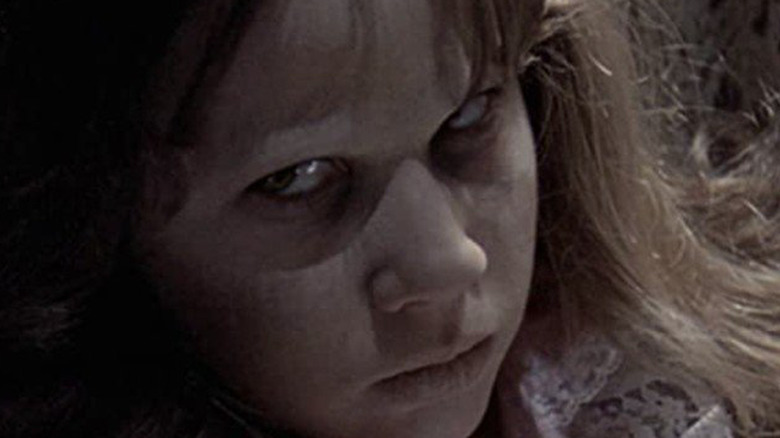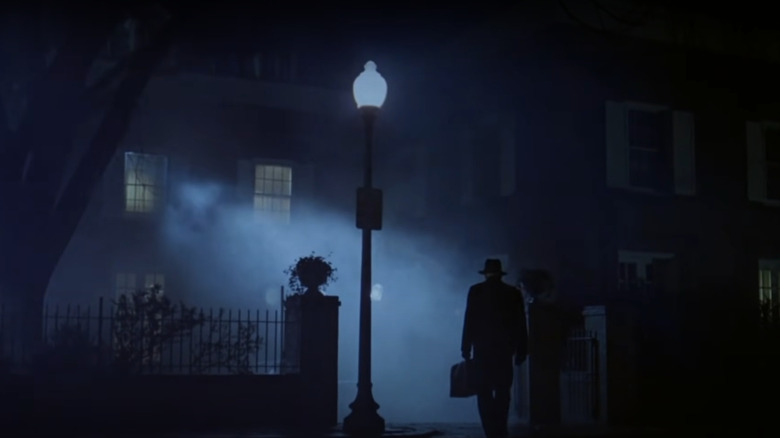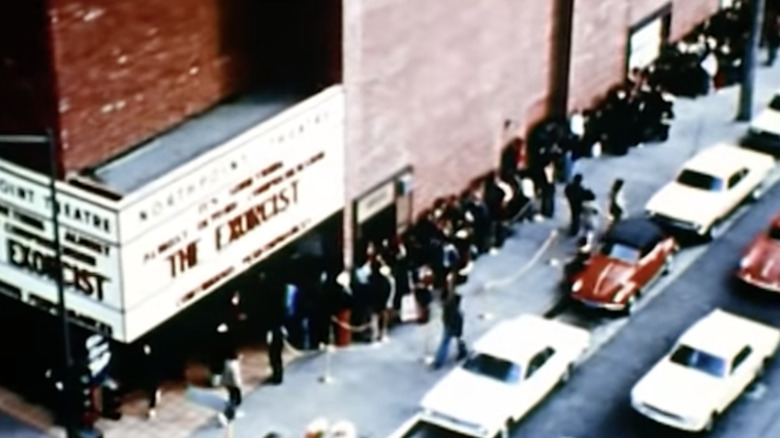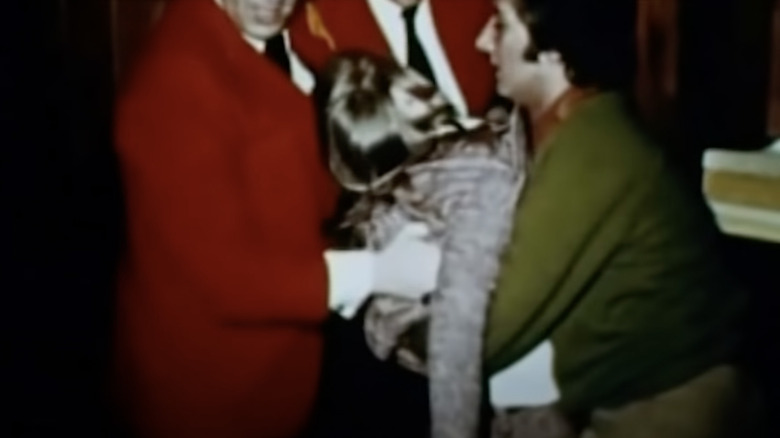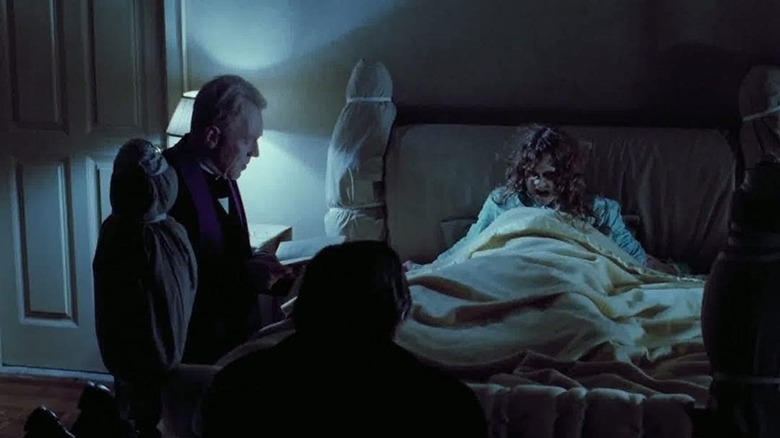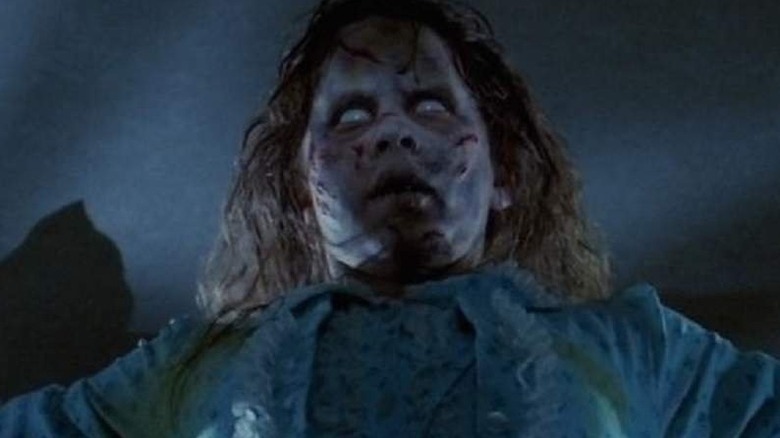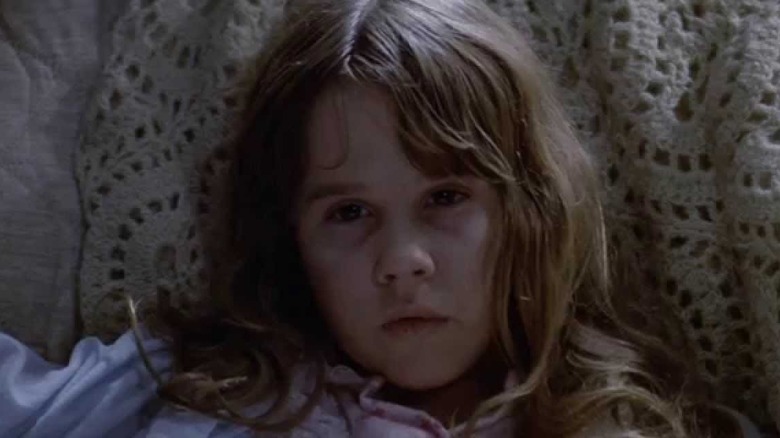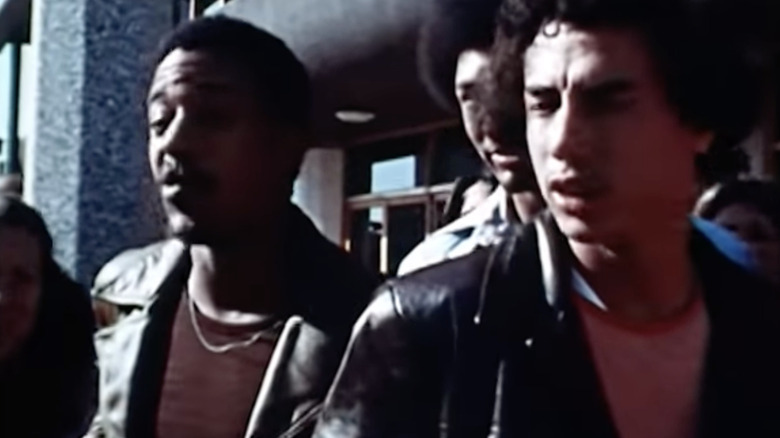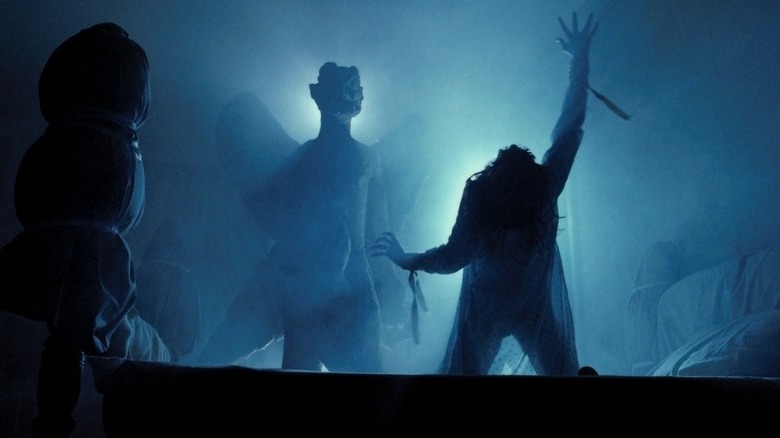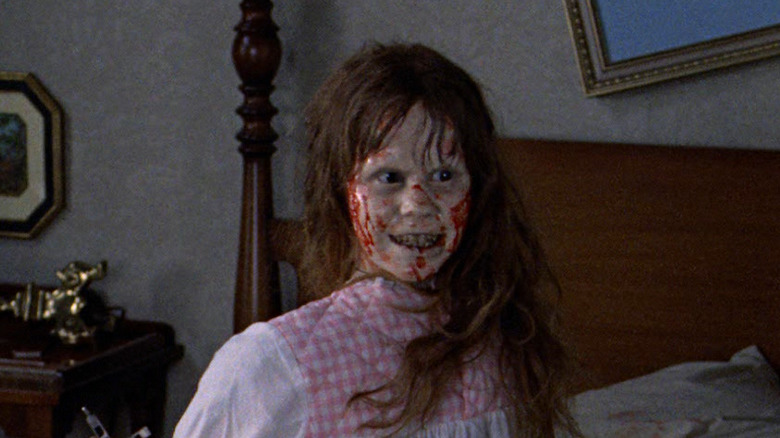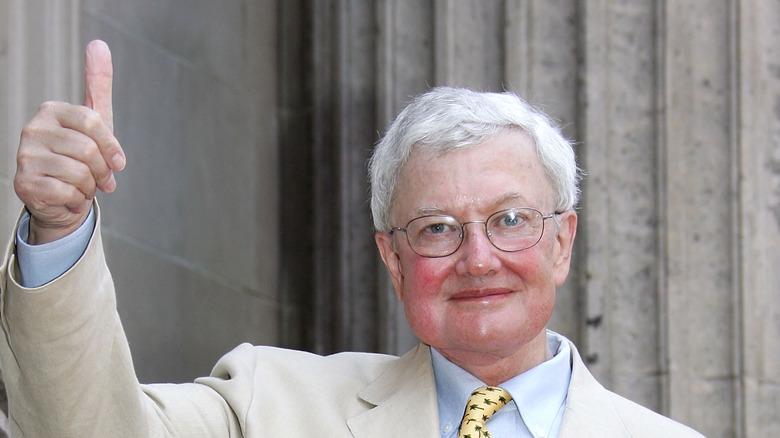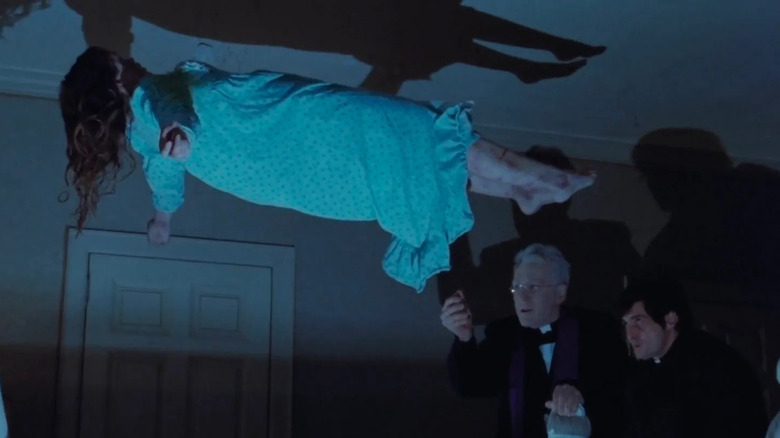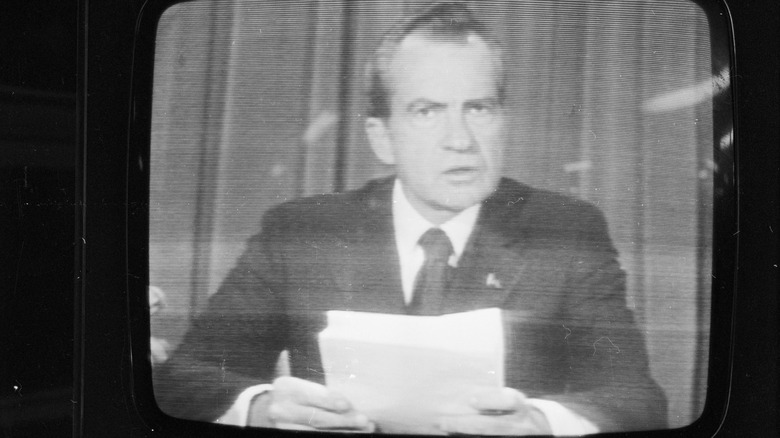What It Was Really Like To See The Exorcist In 1973
Very few horror films hold the levels of critical acclaim and box office success that William Friedkin's "The Exorcist" does. Released in 1973, the adaptation of William Peter Blatty's shocking novel would go on to terrify huge audiences around the United States. The film focuses on young Regan MacNeil (Linda Blair), a 12-year-old girl who is possessed by a cruel demonic entity. Following a plethora of scientific treatments, Regan's mother turns to the church and the aid of two priests, who attempt to perform a risky exorcism and save young Regan's soul from the clutches of nefarious forces.
The shock waves created by this film cannot be overstated, making its original release all the more fascinating. Compiled here are just some of the cultural circumstances "The Exorcist" was thrust into, as well as the public reaction at the time. Dim your lights, lock your doors, and take a peek with us into what it was really like to see "The Exorcist" in 1973.
Its initial release was much smaller
It's common for a studio to make miscalculations when releasing a film, be it in its marketing or release schedule. You don't really know what you have on your hands until you actually release it, after all. In the case of "The Exorcist," Warner Brothers definitely underestimated just how popular the film would end up being: Its eventual impact exceeded anything that they could've possibly anticipated.
In the book "Shock Value" by Jason Zinoman, it's explained that "The Exorcist" was initially planned to have just a limited release in a number of large cities. The film would quickly prove itself to be an immense box office commodity, worthy of a far grander release. Soon enough the film was distributed to a wider array of theaters, turning what was expected to be a relatively small-scale horror movie into a surprise hit through the power of word of mouth.
There were lines around the block
The 1970s are the decade in which the notion of a blockbuster movie would come into being. This can be attributed mostly to big-budget releases like "Jaws" and "Star Wars," both met with big lines at the cineplex and even bigger box office numbers. But one surprising film that can be partially credited for beginning this cinematic shift was "The Exorcist." After the film's initial minuscule release was expanded to more theaters, people began arriving in droves.
If you watch any old news footage detailing the film's widespread success, you'll quickly notice an infectious energy amongst the patrons. This can be attributed to successful word of mouth and the film's release having been heavily publicized in various newspaper ads. Moviegoers had come from all over to wait in line for the film, some paying inflated amounts of money to ensure access to a ticket. Simply put, "The Exorcist" had achieved its desired effect of terrifying its viewers, and audiences were thirsty for more.
People were passing out in the theater
While it's not uncommon for a film to be too intense for some people's sensibilities, "The Exorcist" is definitely a cut above the rest. The sheer terror of "The Exorcist" is an aspect of the film's release that was heavily publicized at the time, with news footage showing people coming out of the movie shaking, often at a loss for words (and oxygen). This was no cheap marketing tactic: "The Exorcist" actually made countless moviegoers ill.
According to William Paul in "Laughing, Screaming," there was so much vomit in his theater's bathroom that reaching the sinks was an impossibility. These public spells of sickness were so commonplace that they became just as well known as the film itself — so much so that popular humor magazine MAD parodied the phenomenon by putting an "Exorcist" barf bag on their cover. Over the years, many horror films have gained notoriety for their shocking content and effect on their audiences. However, very few films can lay claim to the widespread cases of in-house incidents and ambulance calls that "The Exorcist" had.
Many audience members were fans of the novel
The transition from the written page to the silver screen can prove quite the hurdle for any cinematic production. Especially if it's a particularly shocking book, one may wonder whether a cinematic adaptation can do it justice. This was most certainly the case with "The Exorcist," whose massive audience was composed of many different sub-groups. Some were enticed by the film's publicity, others were curious how the film would compare to the book.
For the most part, the cinematic adaptation is actually quite faithful to the book, thanks in part to its screenplay being written by the original author of "The Exorcist," William Peter Blatty. But as with most page-to-screen translations, the book has a bit more time to dedicate to smaller character interactions. The niche fandom for the novel would serve as just one of the many demographics in line for the 1973 adaptation.
Its R Rating made it accessible to mainstream moviegoers
Very rarely does a filmmaker intend to create something so controversial that it'll affect the chances of their film being seen. The linchpin of a wide release is dependent on the Motion Picture Association of America (MPAA), which determines what rating suits a film's content, be it G for General Audiences or R for Restricted.
The latter is what director William Friedkin was hoping to receive leading to the release of "The Exorcist" in 1973. In "Shock Value," author Jason Zinoman explains that Aaron Stern, the head of the MPAA ratings board, called Friedkin to confirm the film's rating himself. Citing "The Exorcist" as an important work, he opted to give it an R rating, as opposed to the more restrictive X rating. At the time, the X rating was the kiss of death for a film hoping to receive any mainstream attention. So by being given the more acceptable R rating, the film was able to reach a much wider audience.
Kids were technically allowed to see it
With the advent of streaming in recent years, some argue that the notion of film ratings has become increasingly obsolete. This is certainly a far cry from the '70s, where a film's rating was crucial in its quest to achieve mainstream success. "The Exorcist" was able to finagle an R rating from the MPAA, which allowed it to be shown in the majority of theaters, rather than being relegated to the handful that would show X-rated films. But this accessibility did have one moderately controversial side effect: The rating meant that minors could technically see the movie.
As long as someone over 18 was present, younger audience members were allowed to attend the soon-to-be horror classic. This factoid was not lost on journalists and critics at the time, resulting in a fair amount of caution and criticism. Following the film's release, reports began circulating about some theaters not properly enforcing the rating, which allowed minors to attend unaccompanied. While the film's R rating led to some controversy, it also paved the way for its success.
The film brought in a very diverse audience
"The Exorcist," for all its horrific imagery and disturbing biblical implications, played a unique role in diversifying cinema marketed to Black Americans. At the time, the Blaxploitation film subgenre, initially conceived of in 1972 by Junius Griffin, then-president of the Beverly Hills-Hollywood branch of the NAACP, was all the rage due to the changing race relations of the decade.
However, this cinematic trend would be knocked for a loop by the theatrical success of "The Exorcist" in 1973. It's noted in "Shock Value" by Jason Zinoman, that Warner Brothers didn't anticipate a substantial Black turnout for the film, and as a result didn't distribute it widely in theaters in predominantly Black neighborhoods. However, this would prove a mistake, with theaters in majority-white areas seeing a more diverse array of moviegoers for this one particular film. In "The Last Great American Picture Show", the editors make a point of citing the film when discussing the changing trends of Hollywood. Due to films like "The Godfather" and "The Exorcist," Hollywood was becoming more comfortable marketing a wider variety of films to Black audiences.
Knowing the horror genre would never be the same
"The Exorcist" pushed boundaries in terms of violence and provocative imagery, a trend that was already on the rise. In the early '70s, the horror genre went through a significant change: The era of tacky-looking monsters and aliens from outer space were quickly becoming an antiquated form of terror. Taking their place would be a new age of horror, one that would stand in sharp contrast to the previous. The Grindhouse subgenre would quickly take center stage, defined by high levels of promiscuity and graphic on-screen violence. From this trend came such unrelenting films as "The Wizard of Gore" and "I Spit on Your Grave," amongst others.
The increasingly shocking and visceral cinematic content would eventually escape the drive-ins and affect mainstream horror as well. Before too long, productions from major studios were embracing this newfound style, with horror films becoming increasingly more graphic. "The Exorcist" would lean heavily into this trend, resulting in what is still referred to by many as one of the scariest films of all time. This development would carry into the '80s with the slasher boom, continuing and evolving further throughout the '90s and '00s.
Some critics didn't like it
While it's widely hailed as a classic today, it's shocking to learn just how many film critics in the '70s didn't care for "The Exorcist." Bear in mind, this was years before the internet would allow fans and critics to have an equal public voice. Professional critics with a regional or national publishing reach would have a major impact on many audiences' perceptions of a particular film, without the soapbox of Twitter to provide more diverse opinions from every corner of the globe.
In the New York Times, film critic Vincent Canby had very few kind words for the film. He reserved praise for its opening sequence, but would refer to the final product as "...an unintelligently put together film." The Village Voice's Andrew Sarris would be even less complimentary, going after director William Friedkin's ability as a visual storyteller. These opinions would, however, not become the majority, with the film receiving ample praise from moviegoers and many other critics.
Roger Ebert heavily praised the film
While some critics at the time were throwing heaps of negative commentary towards "The Exorcist," one critic who thought differently was Roger Ebert. One of cinema's most prolific critics and authors, Ebert always had a level of directness and sincerity to his reviews, never once talking down to his readers. This sincere appreciation of film would serve him well alongside fellow critic Gene Siskel during their run on "At The Movies." Ebert would often defend films that some of his fellow critics were slamming, including "The Exorcist."
Ebert would focus on the film's impressive ability to shock its audience, crediting influence from the culture of the '70s. He would provide special praise to the film's cast and its visceral special effects, exclaiming his bafflement at the film's R rating. He ultimately pondered why people were attending the film in droves, positing that the emotionally numb audiences needed more extreme content to feel something. It's a nuanced take on the film, noting his own reservations but commending "The Exorcist" for its commitment to the story.
It was the highest grossing R-Rated horror film for decades
To say that "The Exorcist" was a success would be a gross understatement, as the film surpassed any expectations the studio had. After its release in the winter of 1973, the film would go on to gross over $190 million during its theatrical run. This shouldn't come as too big of a shock, given the film's immense audience turnout, but it still remains an impressive benchmark. These box office figures would only be supplemented by subsequent theatrical reissuings in the following years. In 2000, "The Exorcist" was re-released in theaters — remastered and with additional scenes — and amassed over $8 million at the box office.
For years, "The Exorcist" held the distinction of being the most successful horror movie release of all time. It would eventually lose that title in 2017 to (coincidentally) another Warner Brothers horror release with "It: Chapter One." Despite no longer being the reigning champ, when adjusted for inflation, "The Exorcist" still stands as one of the most lucrative horror productions.
The film was obscuring a political controversy
The '70s were a time of great transition for the United States in both pop culture and politics. Technology and social movements were evolving, both of which would be compounded by the impact of the Vietnam War on American society. During this time, one of the biggest controversies making headlines across the country was that of the Watergate scandal. In 1972, burglars involved with the Nixon administration broke into the Democratic National Committee headquarters at the Watergate office building. The fallout of these events would reveal the involvement of then-President Richard Nixon, resulting in his subsequent resignation from office.
The news coverage following Watergate was almost constant, with seemingly never-ending headlines and updates. But in 1973, a film's release and subsequent box office success would end up dominating the news cycle alongside Watergate. As is stated in "Shock Value" by Jason Zinoman, that film — much to the chagrin of many journalists — was "The Exorcist." When your film is being mentioned in the same news cycle as a once-in-a-generation political controversy, chances are you have a hit on your hands.
